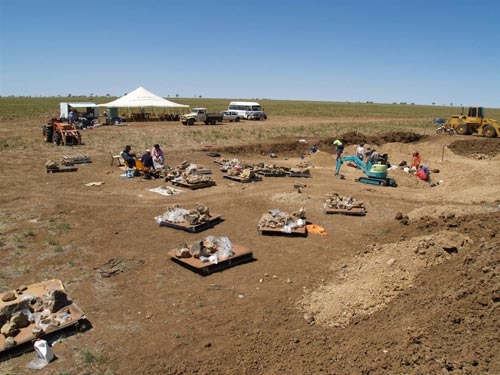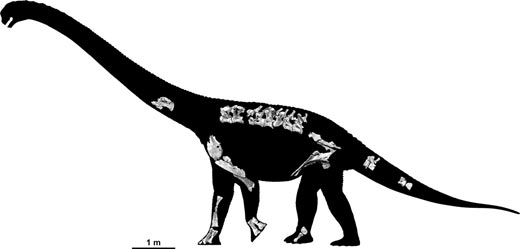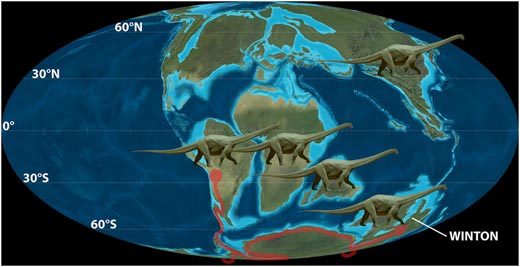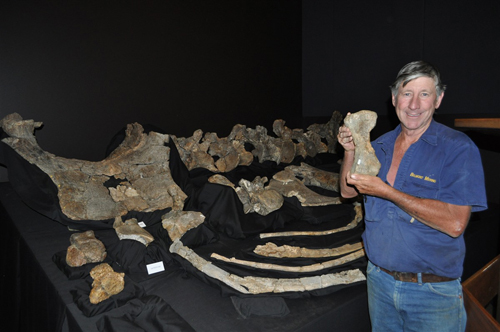“Wade” Finally Gets a Name – Savannasaurus elliottorum
An Australian titanosaur, nicknamed “Wade”, whose fossilised bones were discovered in 2005, has been formally described and named. Say hello to Savannasaurus elliottorum, the scientific name may not be as catchy as its nickname, but this specimen does represent one of the most complete titanosaurs discovered in Australia to date and its discovery is helping palaeontologists to piece together how these giant, herbivorous dinosaurs crossed continents, spreading out from South America and reaching Australia via Antarctica.
An Illustration of the Newly Described Titanosaur Savannasaurus elliottorum
Picture credit: Travis Tischler/Australian Age of Dinosaurs Museum
An Australian Giant – Savannasaurus elliottorum
David Elliot, one of the co-founders of the Australian Age of Dinosaurs Museum, the museum established close to the town of Winton in Queensland that exhibits many of the Cretaceous fossils found in this region, spotted some fossil bones sticking out of the ground early in 2005. Mr Elliott returned to the site later in the day with his wife Judy to take a closer look at the fossil fragments. He hoped that the bones might represent a theropod, but this idea was quickly put to one side when his wife “clicked” two bones together to make a distinctive metatarsal (toe bone) of a sauropod.
The site was excavated in September 2005 by a joint Australian Age of Dinosaurs Museum and Queensland Museum team and seventeen pallets of bones encased in rock were recovered.
The Location of the Savannasaurus elliottorum Fossil Find
Picture credit: Australian Age of Dinosaurs Museum/Site photo circa 2005
It has taken more than ten years or preparation work for the fossilised bones to be removed from the single silt stone concretion that encased them. Everything Dinosaur has regularly reported on Australian dinosaur fossil discoveries and kept tabs on the progress of the “Wade” preparation work.
To read an earlier article (2013), on the preparation work: An Update on Wade the Aussie Dinosaur.
Why “Wade”?
The nickname for this new species of titanosaur honours Australian palaeontologist Dr Mary J. Wade. During her long career, Dr Wade did much to help conserve and promote the extensive, exposed fossil bearing strata of Queensland. She worked on a number of iconic Australian dinosaurs including Muttaburrasaurus as well as helping to map and study Precambrian fossils that were later to be described as Ediacaran biota.
Although one of the more complete Australian titanosaur fossils yet described, the material is highly fragmentary and only about five percent of the skeleton has been recovered. The fossils consist of one neck vertebra, several cervical ribs, eight dorsal vertebrae making up a partial sequence, several rib fragments, sacral vertebrae and at least five fragmentary tail bones (caudal vertebrae). Limb bones are represented, several toe bones, elements from the ankle, bones from the manus (front feet) as well as incomplete humeri (upper arm bones).
The research team and volunteers were also able to recover a partial left radius and a highly fragmentary ulna and parts of the hip girdle. Although no cranial (skull) material was recovered, the team were confident, almost from the start, that these bones represented a new species. The fossils come from a site called “Belmont Station”, ironically, nearby cranial material from another, previously described titanosaur was found (Diamantinasaurus matildae). In the scientific paper which describes Savannasaurus, published in the journal “Nature”, the authors, which include lead researcher Dr Stephen Poropot, (Australian Age of Dinosaurs Museum), describe the braincase and neck bones of Diamantinasaurus.
The Fossil Bones of Savannasaurus elliottorum Mapped onto an Outline of the Dinosaur
Picture credit: Australian Age of Dinosaurs Museum
Plotting the Distribution of the Titanosauria
These two titanosaurs are being used to help map the dispersal of the Titanosauria across the super-continent Gondwana as this huge landmass began to break up. Although the fossil record remains patchy to say the least, the fossils, which have been dated to around 98-95 million years ago (Cenomanian faunal stage of the Late Cretaceous), suggest that by this time in Earth’s history titanosaurs had dispersed from South America, migrated across Antarctica and entered the landmass that was later to become Australia.
Commenting on the significance of these fossils, Dr Stephen Poropot stated:
“We get a much better idea of the overall fauna. And as a result, we can start piecing together how climate affected these dinosaurs, how the positions of the continent affected those dinosaurs and how they evolved through time as well.”
The Dispersal and Spread of Titanosaurs Across High Latitudes in the Southern Hemisphere
Picture credit: Ron Blakey (Colorado Plateau Geosystems Inc)
Dispersal of the Titanosauria
Although, palaeontologists have discussed a number of potential dispersal routes, it is likely that these types of dinosaurs had entered Australia from South America, presumably crossing Antarctica. During the late Early Cretaceous the Earth went through a period of global warming. Prior to this climate change, titanosaurs, which were globally widespread in the Early Cretaceous were prevented from reaching Australia by the cold conditions in Antarctica. Global warming facilitated the dispersal of sauropods from South America to Australia via Antarctica.
For models and replicas of titanosaurs and other sauropods: CollectA Scale Dinosaur Models (CollectA Deluxe Figures).
David Elliott Co-founder of the Australian Age of Dinosaurs Museum Poses with the Savannasaurus elliottorum Fossil Material
Picture credit: Australian Age of Dinosaurs Museum
Etymology of Savannasaurus elliottorum
The genus name is derived from the Spanish (Taino) “zavana”(savanna), a reference to the grassland and pasture in which the specimen was found. The species name honours the Elliott family for their continuing contributions to Australian palaeontology.
Differences between Savannasaurus and Diamantinasaurus
Although Savannasaurus and Diamantinasaurus were contemporaneous of each other and these giant herbivores may have been roughly the same size, living in the same habitat, preliminary measurements indicate that the forelimbs of Savannasaurus are proportionally quite different from those of Diamantinasaurus. This may suggest adaptation to a different feeding platform, allowing these large dinosaurs to co-exist without competing with each other for food.
Visit Everything Dinosaur’s website: Everything Dinosaur.











Leave A Comment